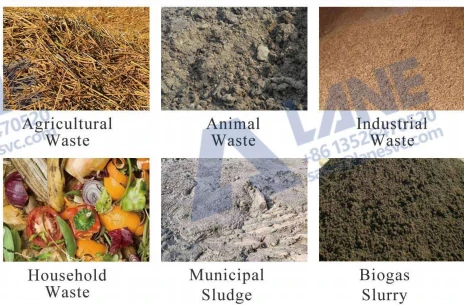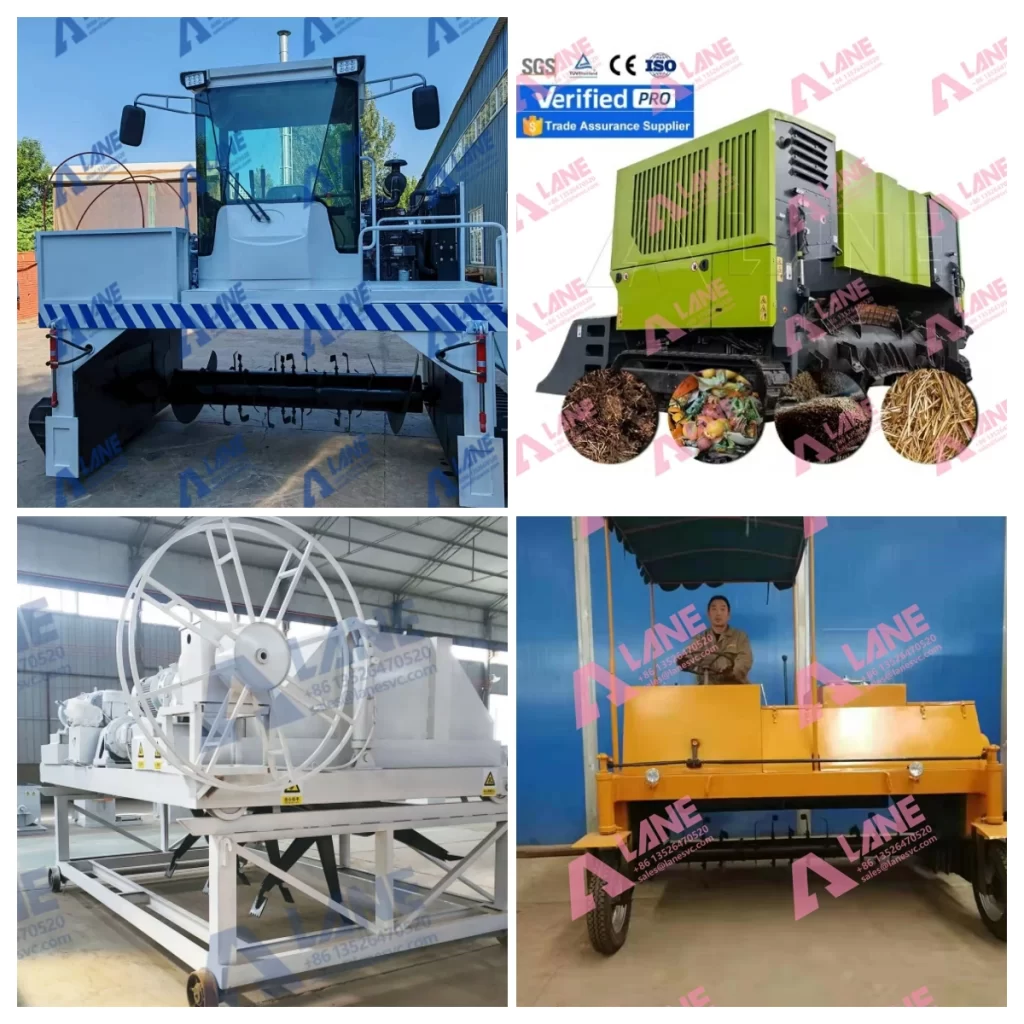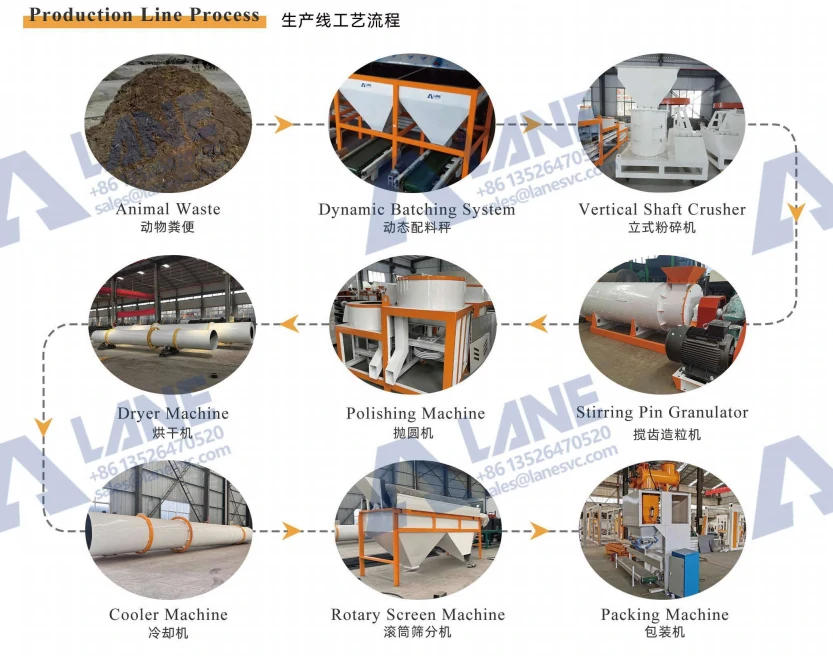In modern sustainable agriculture, knowing how to build an aerobic composting system for organic fertilizer is essential for turning organic waste into valuable soil nutrients. This technology uses oxygen-driven microbial activity to transform manure, crop residues, and organic waste into high-quality compost efficiently and safely.

An aerobic composting system for organic fertilizer ensures faster decomposition, minimal odor, and higher nutrient retention compared to anaerobic methods. With growing demand for eco-friendly fertilizers, industries and farms are investing in advanced composting solutions developed by experienced manufacturers like LANE Heavy Industry — known for their durable machinery, energy efficiency, and turnkey fertilizer production systems.
Understanding the Aerobic Composting System for Organic Fertilizer
An aerobic composting system for organic fertilizer is a controlled biological process where microorganisms decompose organic materials such as animal manure, crop residues, and food waste in the presence of oxygen. The result is a nutrient-rich compost that can be directly used as fertilizer or further processed into granular organic fertilizer.
During composting, the aerobic microorganisms consume oxygen and convert organic carbon into carbon dioxide, water, and heat. This heat raises the pile temperature to 55–70°C, killing weed seeds, harmful bacteria, and parasites — producing a hygienic and stable compost.
Core Elements of an Aerobic Composting System
Raw Material Composition — Typically includes livestock manure, agricultural residues, and organic sludge.
Aeration — Continuous oxygen supply is critical to maintain microbial activity.
Temperature and Moisture Control — Optimal ranges (55–65°C, 50–60% moisture) must be maintained.
Mechanical Turning — Performed by specialized machines such as the crawler type compost turner.
Fermentation Time — Usually 15–20 days for complete compost maturity under proper aeration.
LANE Heavy Industry integrates all these elements into automated, modular composting systems that can handle from 1 to 30 tons per hour, suitable for farms, fertilizer factories, and municipal waste facilities.
The Science Behind Aerobic Composting
The aerobic composting system for organic fertilizer relies on microbial activity — primarily bacteria, actinomycetes, and fungi — that thrive in oxygen-rich environments. These microbes break down complex organic compounds like cellulose and proteins into simpler forms that plants can easily absorb.
During this process, energy is released as heat, which sterilizes the compost naturally. The heat phase (thermophilic stage) is followed by a cooling and maturation phase, resulting in dark, humus-like compost with high nutrient stability.
Unlike anaerobic methods, aerobic composting produces minimal odor and greenhouse gas emissions. It also offers faster decomposition rates, making it the preferred choice for sustainable agriculture and large-scale organic fertilizer production.
Equipment Used in Aerobic Composting Systems
A complete aerobic composting system for organic fertilizer typically includes several key machines that ensure efficient and uniform composting.
(1) Compost Turner Machines
Mechanical turning ensures even oxygen distribution, temperature control, and uniform decomposition.
Crawler Type Compost Turner – Ideal for outdoor windrow composting; flexible, powerful, and efficient.
Wheel Type Compost Turner – Designed for large-scale trench composting systems with automatic control.
Groove Type Compost Turner – Operates on fixed rails within fermentation trenches, perfect for indoor composting.
LANE Heavy Industry offers all three types, each built with durable materials, hydraulic lifting systems, and adjustable speeds.

(2) Aeration Systems
Aeration pipes or blowers supply oxygen to the compost pile. In large installations, LANE’s systems include automatic air distribution to maintain optimal microbial conditions.
(3) Temperature and Moisture Monitoring
LANE integrates smart sensors and PLC control panels that monitor compost temperature, humidity, and oxygen concentration in real-time, ensuring ideal fermentation conditions.
(4) Auxiliary Equipment
Mixing Machines – For pre-blending raw materials.
Crushing Machines – To break large clumps of manure or residue.
Screening Machines – For grading and removing impurities after composting.
Automatic Packaging Systems – For bagging the finished compost or organic fertilizer.
Process Flow of an Aerobic Composting System for Organic Fertilizer
(1) Raw Material Collection and Mixing
Collect manure, crop waste, or organic residues. Adjust the carbon-to-nitrogen (C/N) ratio to 25–30:1. Add materials like rice husk or straw to improve aeration.
(2) Piling and Initial Aeration
Pile the materials in windrows or fermentation grooves. Start the aeration system or perform initial turning using a crawler or groove-type compost turner.
(3) Thermophilic Fermentation Stage
As microbial activity increases, temperature rises above 55°C. Regular turning every 2–3 days ensures even heat distribution and oxygen supply.
(4) Cooling and Maturation
After 15–20 days, the temperature drops naturally. Continue turning less frequently to stabilize organic matter. The compost color darkens, and odor diminishes.
(5) Screening and Refining
Use a rotary drum screener to separate fine compost from larger particles. Oversized materials can be re-composted.
(6) Optional Granulation
Mature compost can be further processed with LANE’s stirring pin granulator or double roller granulator to produce uniform organic fertilizer pellets.
(7) Packaging and Storage
The final organic fertilizer is packed using automatic bagging machines for commercial sale or on-farm use.

The aerobic composting system for organic fertilizer represents the future of sustainable waste management and eco-friendly fertilizer production. By harnessing natural microbial processes, it converts organic waste into nutrient-rich compost while protecting the environment.
With advanced technology, durable machinery, and years of practical experience, LANE Heavy Industry delivers comprehensive composting solutions that empower farms, industries, and governments to embrace circular agriculture. Whether for small-scale farms or industrial composting plants, LANE’s systems ensure efficiency, reliability, and long-term value.
For more details, please feel free to contact us.
Henan Lane Heavy Industry Machinery Technology Co., Ltd.
Email: sales@lanesvc.com
Contact number: +86 13526470520
Whatsapp: +86 13526470520